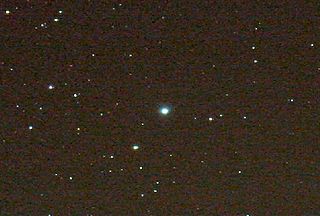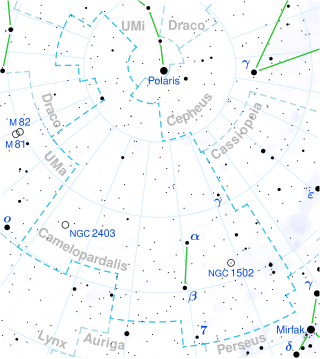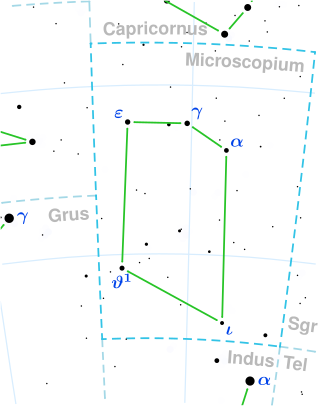Related Research Articles

19 Aquilae is a single star located 142 light-years away from the Sun in the equatorial constellation of Aquila. 19 Aquilae is the Flamsteed designation. It is visible to the naked eye as a dim, yellow-white hued star with an apparent visual magnitude of 5.23. The star is moving closer to the Earth with a heliocentric radial velocity of −46.7 km/s.
HD 92845 is a probable astrometric binary in the southern constellation Antlia. It has an apparent magnitude of 5.62, allowing it to be faintly seen with the naked eye. Parallax measurements place the system at a distance of 790 light years and it is currently receding with a heliocentric radial velocity of 4.5 km/s.
HD 152010 is a solitary star in the southern circumpolar constellation Apus. It has an apparent magnitude of 6.48, placing it near the max visibility for the naked eye. Located 1,006 light yearsaway, the object is approaching the Solar System with a heliocentric radial velocity of −15 km/s.
HD 32518 b, formally named Neri, is an extrasolar planet which orbits the K-type giant star HD 32518, located 399.7 light years away in the constellation Camelopardalis. It has a minimum mass three times greater than Jupiter and orbits the intermediate-mass giant star at a distance of only 0.59 AU in a very circular orbit. The orbit takes 10.35 months to complete one round trip around the star. This planet was detected by the radial velocity method on August 12, 2009.
11 Ursae Minoris is a single star located approximately 410 light years away in the northern circumpolar constellation of Ursa Minor. The star is visible to the naked eye as a faint, orange-hued star with an apparent visual magnitude of 5.15. It is moving closer to the Earth with a heliocentric radial velocity of −17.5 km/s.
HD 64307, also known as HR 3075, is a solitary, orange hued star located in the northern circumpolar constellation Camelopardalis. It has an apparent magnitude of 5.35, allowing it to be faintly seen with the naked eye. Based on parallax measurements from the Gaia spacecraft, The object is estimated to be 690 light years distant. It appears to be receding from the Sun, having a heliocentric radial velocity of 34 km/s.

HD 199223 is a double star in the equatorial constellation Delphinus. However, the system was originally in Equuleus prior to the creation of official IAU constellation borders. The components have a separation of 2″ at a position angle of 282° as of 2016. They have apparent magnitudes of 6.34 and 7.49 and distances of 354 and 359 light years respectively. The system is drifting closer with a radial velocity of −33 km/s.
HD 194953 is a solitary star in the equatorial constellation Delphinus. It is faintly visible to the naked eye with an apparent magnitude of 6.19 and is located 414 light years away. However, it is approaching the Solar System with a heliocentric radial velocity of −28 km/s.
HD 89571 is a binary star located in the northern circumpolar constellation Camelopardalis. It is faintly visible to the naked eye with a combined apparent magnitude of 5.51 and is estimated to be 142 light years away from the Solar System. However, it is receding with a heliocentric radial velocity of 3.5 km/s.
HD 68375 is a solitary star in the northern circumpolar constellation Camelopardalis. It is faintly visible to the naked eye with an apparent magnitude of 5.54 and is estimated to be 289 light years distant. However, it is receding with a heliocentric radial velocity of 4.33 km/s.
HD 50885, also known as HR 2581, is a star located in the northern circumpolar constellation Camelopardalis, the giraffe. It has an apparent magnitude of 5.69, making it faintly visible to the naked eye if viewed under ideal conditions. Based on parallax measurements from Gaia DR3, the object is estimated to be 513 light years distant. It appears to be approaching the Solar System with a heliocentric radial velocity of −17.8 km/s.

23 Leonis Minoris is a solitary, bluish-white hued star located in the northern constellation Leo Minor. It is positioned 7° south and 11" west from β Leonis Minoris. It is rarely called 7 H. Leonis Minoris, which is its Hevelius designation.
HD 59640 is a solitary white hued star located in the southern circumpolar constellation Volans. It has an apparent magnitude of 6.48, placing it near the limit for naked eye visibility. Gaia DR3 parallax measurements place the object at a distance of 262 light years and it is receding with a heliocentric radial velocity of 18.4 km/s. At its current distance, HD 59640's brightness is diminished by three tenths of a magnitude due to interstellar dust.

HD 31134, also designated as HR 1561, is a solitary star located in the northern circumpolar constellation Camelopardalis, the giraffe. It is faintly visible to the naked eye as a white-hued star with an apparent magnitude of 5.74. Gaia DR3 parallax measurements place it 473 light years away. It appears to be approaching the Solar System with a heliocentric radial velocity of −15.1 km/s. At its current distance, HD 31134's brightness is diminished by 0.35 magnitudes due to interstellar dust. It has an absolute magnitude of +0.19.
8 Ursae Minoris is a 7th-magnitude red clump star in Ursa Minor. The star is unusually rich in lithium, with an abundance of A = 2.0±0.2 dex.

HD 46509, also designated as HR 2396, is a solitary star located in the northern circumpolar constellation Camelopardalis, the giraffe. It is faintly visible to the naked eye as a yellowish-orange hued point of light with an apparent magnitude of 5.86. The object is located relatively far at a distance of 791 light-years based on Gaia DR3 parallax measurements, but it is drifting closer with a heliocentric radial velocity of −24.02 km/s. At its current distance, HD 46509's brightness is diminished by interstellar extinction of 0.31 magnitudes and it has an absolute magnitude of −0.98.

HD 28780, also known as HR 1440, is a solitary white-hued star located in the northern circumpolar constellation Camelopardalis. It has an apparent magnitude of 5.91, making it faintly viisble to the naked eye under ideal conditions. Gaia DR3 parallax measurements imply a distance of 488 light-years, and it is currently drifting closer with a heliocentric radial velocity of −22.6 km/s. At its current distance, HD 28780's brightness is diminished by 0.33 magnitudes due to interstellar extinction and it has an absolute magnitude of +0.26.

HD 28204, also designated as HR 1401, is a spectroscopic binary located in the northern circumpolar constellation Camelopardalis. It has an apparent magnitude of 5.93, making it faintly visible to the naked eye under ideal conditions. Gaia DR3 parallax measurements imply a distance of 331 light-years and it is currently receding with a heliocentric radial velocity of 9 km/s. At its current distance, HD 28204's brightness is diminished by 0.18 magnitudes due to interstellar extinction and it has an absolute magnitude of +0.91.

HD 201852 is a solitary star located in the southern constellation Microscopium. It is faintly visible to the naked eye as an orange-hued point of light with an apparent magnitude of 5.95. Gaia DR3 parallax measurements imply a distance of 365 light-years and it is slowly receding with a heliocentric radial velocity of 0.4 km/s. At its current distance, HD 201852's brightness is diminished by an interstellar extinction of 0.11 magnitudes and it has an absolute magnitude of +0.73.

HD 32356, also designated as HR 1624, is an astrometric binary located in the northern circumpolar constellation Camelopardalis, the giraffe, near β Camelopardalis. The visible component is faintly visible to the naked eye as an orange-hued star with an apparent magnitude of 5.99. Gaia DR3 parallax measurements imply a distance of 557 light-years and it is currently drifting closer with a heliocentric radial velocity of −45.2 km/s. At its current distance, HD 32356's brightness is diminished by an interstellar extinction of 0.29 magnitudes and it has an absolute magnitude of +0.23.
References
- 1 2 3 4 5 6 Vallenari, A.; et al. (Gaia collaboration) (2023). "Gaia Data Release 3. Summary of the content and survey properties". Astronomy and Astrophysics. 674: A1. arXiv: 2208.00211 . Bibcode:2023A&A...674A...1G. doi: 10.1051/0004-6361/202243940 . S2CID 244398875. Gaia DR3 record for this source at VizieR.
- 1 2 Oja, T. (August 1991). "UBV photometry of stars whose positions are accurately known. VI". Astronomy and Astrophysics Supplement Series. 89: 415. Bibcode:1991A&AS...89..415O. ISSN 0365-0138.
- 1 2 3 4 5 6 7 Ting, Yuan-Sen; Hawkins, Keith; Rix, Hans-Walter (3 May 2018). "A Large and Pristine Sample of Standard Candles across the Milky Way: ~100,000 Red Clump Stars with 3% Contamination". The Astrophysical Journal. 858 (1): L7. arXiv: 1803.06650 . Bibcode:2018ApJ...858L...7T. doi: 10.3847/2041-8213/aabf8e . ISSN 0004-637X.
- 1 2 Halliday, Ian (September 1955). "Luminosity Function and Space Motions of G8-K1 Stars Derived from Spectroscopic Parallaxes". The Astrophysical Journal. 122: 222. Bibcode:1955ApJ...122..222H. doi: 10.1086/146080 . ISSN 0004-637X.
- 1 2 Oja, T. (April 1983). "UVB photometry of FK4 and FK4 Supplement stars". Astronomy and Astrophysics Supplement Series. 52: 131–134. Bibcode:1983A&AS...52..131O. ISSN 0365-0138.
- 1 2 Famaey, B.; Jorissen, A.; Luri, X.; Mayor, M.; Udry, S.; Dejonghe, H.; Turon, C. (January 2005). "Local kinematics of K and M giants from CORAVEL/Hipparcos/Tycho-2 data: Revisiting the concept of superclusters". Astronomy & Astrophysics. 430 (1): 165–186. arXiv: astro-ph/0409579 . Bibcode:2005A&A...430..165F. doi: 10.1051/0004-6361:20041272 . ISSN 0004-6361.
- ↑ Anderson, E.; Francis, Ch. (May 2012). "XHIP: An extended hipparcos compilation". Astronomy Letters. 38 (5): 331–346. arXiv: 1108.4971 . Bibcode:2012AstL...38..331A. doi:10.1134/S1063773712050015. ISSN 1063-7737. S2CID 255204555.
- 1 2 3 4 5 6 7 8 Bonfanti, A.; et al. (2015). "Revising the ages of planet-hosting stars". Astronomy and Astrophysics. 575. A18. arXiv: 1411.4302 . Bibcode:2015A&A...575A..18B. doi:10.1051/0004-6361/201424951. S2CID 54555839.
- 1 2 de Medeiros, J. R.; Mayor, M. (November 1999). "A catalog of rotational and radial velocities for evolved stars". Astronomy and Astrophysics Supplement Series. 139 (3): 433–460. Bibcode:1999A&AS..139..433D. doi: 10.1051/aas:1999401 . ISSN 0365-0138.
- ↑ "HD 32518". SIMBAD . Centre de données astronomiques de Strasbourg . Retrieved 2023-12-14.
- 1 2 Döllinger, M.; et al. (2009). "Planetary companions around the K giant stars 11 Ursae Minoris and HD 32518". Astronomy and Astrophysics. 505 (3): 1311–1317. arXiv: 0908.1753 . Bibcode:2009A&A...505.1311D. doi:10.1051/0004-6361/200911702. S2CID 9686080.
- ↑ "International Astronomical Union | IAU". www.iau.org. Retrieved 2020-01-02.
- ↑ "Approved names". NameExoworlds. Retrieved 2020-01-02.
- ↑ "Abstimmung über Exoplaneten-Namen: Planet Neri umkreist Stern Mago". www.haus-der-astronomie.de. Retrieved 2020-01-02.